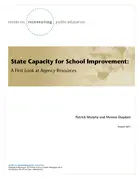The current emphasis on school performance and accountability is expected to continue. As a consequence, the number of low-performing schools will increase as academic achievement targets become more stringent. In response, the federal government has begun to look to state education agencies (SEAs) to play a more direct role in turning around schools in need of improvement. This increased emphasis, however, takes place at a time when public resources are becoming increasingly constrained.
The expectation that SEAs will play an expanded role in turning around low-performing schools raises a critical question: Will SEAs have the capacity to fulfill their new obligations? This study from the Center on Reinventing Public Education takes a first step toward answering that question, by examining how SEAs currently allocate their resources. Specifically, researchers asked:
- What functions do SEAs perform?
- How do SEAs distribute their resources across these functions?
- How does resource allocation compare across states relative to the scale of their responsibilities?
- What are the funding sources of SEA activities and do these sources vary across functions?
To answer these questions, researchers examined SEAs in eight states: California, Colorado, Louisiana, Minnesota, New York, Tennessee, Texas, and Washington.
Overall, researchers found the current investment in school improvement activities to be relatively modest, though the distribution varied across the states. This current assessment presents a relatively bleak picture in terms of SEAs’ capacity to play a greater role in school improvement. And this pessimistic impression is intensified by the fact that few additional resources are likely to be forthcoming, at least out of state general funds. In response to this fiscal reality, this report explores possible options for managing state agencies so that they are better positioned to play a central role in improving failing schools. The report concludes that greater flexibility in how SEAs allocate federally funded personnel would be a positive first step in an otherwise constrained environment.





